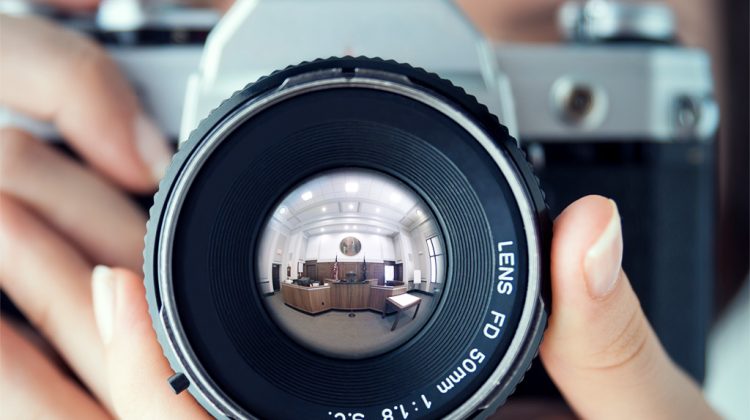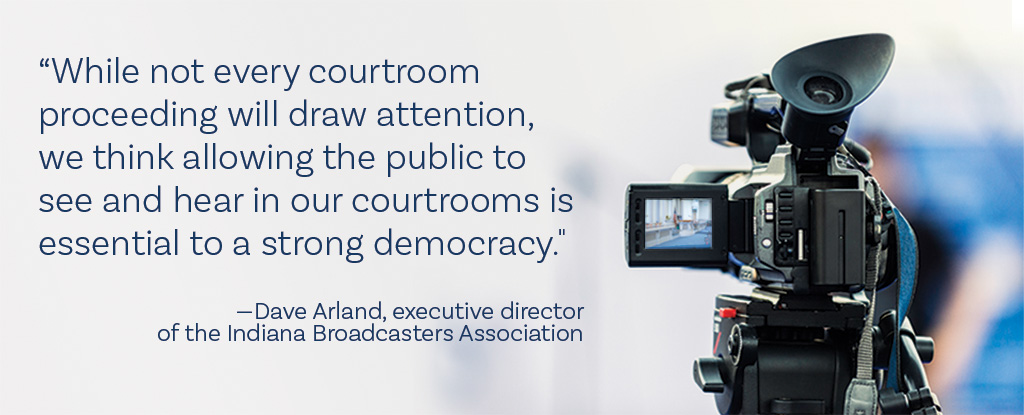Rule change gives local judges discretion to allow cameras into their courtrooms
By Kathryn Dolan, Chief Public Information Officer • Office of Communication, Education & Outreach

As of May 1, judicial officers around the state have the authority to allow news media into their courtrooms to broadcast, televise, record, digitally stream, or photograph court proceedings that are not confidential.
The Code of Judicial Conduct has long prohibited broadcasting, recording, or taking photographs in and around courtrooms without prior approval by the Indiana Supreme Court. After years of discussion, pilot programs, evaluations, and public comment, the Court is amending Judicial Conduct Rule 2.17.
The first line of the rule remains the same: “A judge shall prohibit broadcasting, televising, recording, or taking photographs in the courtroom and areas immediately adjacent thereto.” However, the amendment creates an exception that allows local judges to approve news media requests to film, stream, and photograph proceedings, offering judges a new tool to manage their courtrooms and give greater transparency to their work.
When asked about the amended rule, Amelia McClure, executive director and general counsel of the Hoosier State Press Association, said, “The rule change gives unprecedented access to a part of our government most people will never see. It brings public access and public information into the fold with other elements of due process afforded by our judicial system.”
“While not every courtroom proceeding will draw attention,” said Dave Arland, executive director of the Indiana Broadcasters Association, “we think allowing the public to see and hear in our courtrooms is essential to a strong democracy. Of course, we will also have a responsibility to follow the rules to ensure confidentiality when appropriate.”

Pilot projects allowing cameras in court have been conducted in Indiana several times in the past, including pilots in 2006 and 2012. Longtime work by the Indiana Judicial Conference Community Relations Committee and Court Security Committee, along with the Hoosier State Press Association and the Indiana Broadcasters Association, led to the most recent pilot. During the four-month project beginning in December 2021, five judges worked with press to allow them access and to finetune issues of logistics and decorum together.
“The rule requires that the means of recording must neither distract participants nor impair the dignity of proceedings,” said Magistrate Jason Reyome (Marion County), Chair of the Court Security Committee. “It also affords judges wide discretion to ensure the safety of all participants.”
Commentary included with the rule provides conditions for access beyond the requirement that proceedings must not be confidential. For example, certain people—including minors and jurors—may not be shown on camera, only news media as defined in Ind. Code § 34-46-4-1 may be authorized, and the judge may revoke authorization at any time for any reason.
“The courtroom is a special place where thoughtful decisions impacting people and businesses are made every day,” said Judge Maria Granger (Floyd County), Chair of the Community Relations Committee. “The cameras serve to increase the public’s understanding of court processes and outcomes, especially the upholding of important constitutional rights belonging to all Hoosiers.”
As judges around the state begin using the new rule, developing policies and procedures, and learning from the experience, the Office of Judicial Administration will work to take their feedback and prepare resources that judges across the state can duplicate locally.